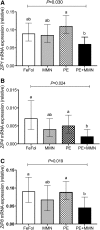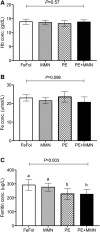mRNA Levels of Placental Iron and Zinc Transporter Genes Are Upregulated in Gambian Women with Low Iron and Zinc Status
- PMID: 28515164
- PMCID: PMC5483961
- DOI: 10.3945/jn.116.244780
mRNA Levels of Placental Iron and Zinc Transporter Genes Are Upregulated in Gambian Women with Low Iron and Zinc Status
Abstract
Background: The role of the placenta in regulating micronutrient transport in response to maternal status is poorly understood.Objective: We investigated the effect of prenatal nutritional supplementation on the regulation of placental iron and zinc transport.Methods: In a randomized trial in rural Gambia [ENID (Early Nutrition and Immune Development)], pregnant women were allocated to 1 of 4 nutritional intervention arms: 1) iron and folic acid (FeFol) tablets (FeFol group); 2) multiple micronutrient (MMN) tablets (MMN group); 3) protein energy (PE) as a lipid-based nutrient supplement (LNS; PE group); and 4) PE and MMN (PE+MMN group) as LNS. All arms included iron (60 mg/d) and folic acid (400 μg/d). The MMN and PE+MMN arms included 30 mg supplemental Zn/d. In a subgroup of ∼300 mother-infant pairs, we measured maternal iron status, mRNA levels of genes encoding for placental iron and zinc transport proteins, and cord blood iron levels.Results: Maternal plasma iron concentration in late pregnancy was 45% and 78% lower in the PE and PE+MMN groups compared to the FeFol and MMN groups, respectively (P < 0.001). The mRNA levels of the placental iron uptake protein transferrin receptor 1 were 30-49% higher in the PE and PE+MMN arms than in the FeFol arm (P < 0.031), and also higher in the PE+MMN arm (29%; P = 0.042) than in the MMN arm. Ferritin in infant cord blood was 18-22% lower in the LNS groups (P < 0.024). Zinc supplementation in the MMN arm was associated with higher maternal plasma zinc concentrations (10% increase; P < 0.001) than in other intervention arms. mRNA levels for intracellular zinc-uptake proteins, in this case zrt, irt-like protein (ZIP) 4 and ZIP8, were 96-205% lower in the PE+MMN arm than in the intervention arms without added zinc (P < 0.025). Furthermore, mRNA expression of ZIP1 was 85% lower in the PE+MMN group than in the PE group (P = 0.003).Conclusion: In conditions of low maternal iron and in the absence of supplemental zinc, the placenta upregulates the gene expression of iron and zinc uptake proteins, presumably in order to meet fetal demands in the face of low maternal supply. The ENID trial was registered at www.controlled-trials.com as ISRCTN49285450.
Keywords: intervention; iron; lipid-based nutrient supplement; mRNA; micronutrient; placenta; prenatal; transporter; zinc.
Conflict of interest statement
Author disclosures: MLJ, HJM GH, EAS, AMP, and SEM, no conflicts of interest.
Figures






References
-
- Black RE, Victora CG, Walker SP, Bhutta ZA, Christian P, de Onis M, Ezzati M, Grantham-McGregor S, Katz J, Martorell R, et al. . Maternal and child undernutrition and overweight in low-income and middle-income countries. Lancet 2013;382:427–51. - PubMed
-
- McLean E, Cogswell M, Egli I, Wojdyla D, de Benoist B. Worldwide prevalence of anaemia, WHO Vitamin and Mineral Nutrition Information System, 1993–2005. Public Health Nutr 2009;12:444–54. - PubMed
-
- Caulfield LE, Zavaleta N, Shankar AH, Merialdi M. Potential contribution of maternal zinc supplementation during pregnancy to maternal and child survival. Am J Clin Nutr 1998;68:499S–508S. - PubMed
-
- Black RE, Allen LH, Bhutta ZA, Caulfield LE, de Onis M, Ezzati M, Mathers C, Rivera J. Maternal and child undernutrition: global and regional exposures and health consequences. Lancet 2008;371:243–60. - PubMed
-
- Christian P. Micronutrients, birth weight, and survival. Annu Rev Nutr 2010;30:83–104. - PubMed
Publication types
MeSH terms
Substances
Associated data
Grants and funding
LinkOut - more resources
Full Text Sources
Other Literature Sources
Medical

